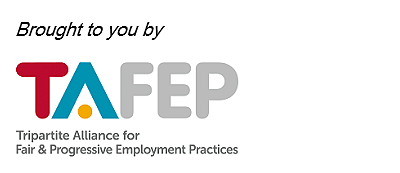Singapore’s first workplace fairness law is slated to be introduced in the second half of 2024 to give workers better protection against discrimination at work.
Under the proposed Workplace Fairness Legislation, employers are required to put in place proper processes so that aggrieved employees and their employers can attempt to resolve grievances and disputes amicably within the firm early on. This will help build fairer and more harmonious workplaces in Singapore.
The Tripartite Alliance for Fair and Progressive Employment Practices (TAFEP)* answers some commonly-asked questions on resolving workplace grievances.
Q: What is grievance handling and why is it important?
Grievance handling is the management of formal employee complaints – or grievances – about unfair treatment at work.
By establishing formal grievance handling processes, employers provide a safe channel for employees to raise their concerns without fear of retaliation. At the same time, employers have a neutral feedback channel to explain their policies and rationale for certain management decisions.
Employers can also avoid putting their corporate reputation at risk by tackling unacceptable or unfair practices quickly. This assures employees that their concerns are taken seriously, and helps boost their morale and productivity.
Q: What are the steps in grievance handling?
In setting up a formal grievance handling process, employers should follow these steps:
1. Develop a policy
Draw up a grievance handling policy that includes the definition of a grievance, and the objective and intention of the process. It should also clearly outline how employees can raise concerns, the way their grievances will be treated, whom they can approach for guidance and when they can expect a response.
2. Inform internally
Communicate the grievance handling policy and processes via available channels to all staff. These can include employee handbooks, internal memos, staff orientation or meetings, and collective agreements, if the company is unionised.
3. Protect personnel
Keep details of the grievance and the affected employee confidential through a secure reporting channel, such as a dedicated e-mail address, for employees to submit their grievance reports. Employers should also train supervisors or managers to handle sensitive information appropriately, and choose a conducive private venue for any inquiry meetings.
4. Communicate for closure
Provide closure to the grievance by communicating any decision or actions taken to the affected employee.
Q: At what point should TAFEP be involved?
Based on TAFEP’s experience, some grievances arise due to miscommunication and can be resolved with more open communication and clarification. Employees who are unable to resolve the matter within their organisation, or if there is no internal reporting channel, can approach TAFEP for advice and assistance.
To learn more about grievance handling and reporting, visit tafep.sg to view TAFEP’s Grievance Handling Handbook, and other online resources such as samples of policies, lodgement forms and company circulars. Employers can also sign up for the complimentary Tripartite Standard on Grievance Handling virtual clinic for more information.
*TAFEP was set up in 2006 by the tripartite partners (Ministry of Manpower, National Trades Union Congress and Singapore National Employers Federation) to promote the adoption of fair, responsible and progressive employment practices.


